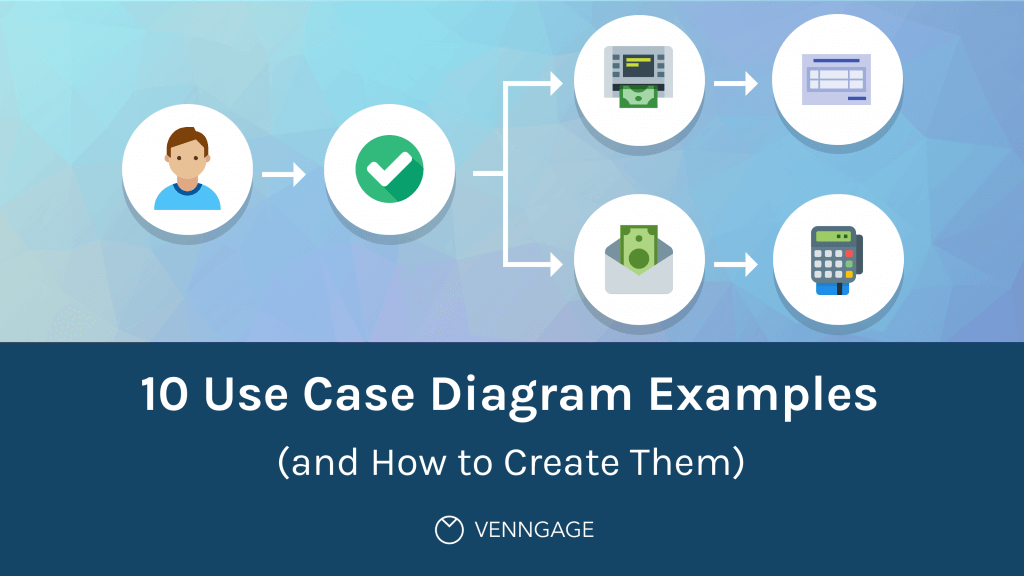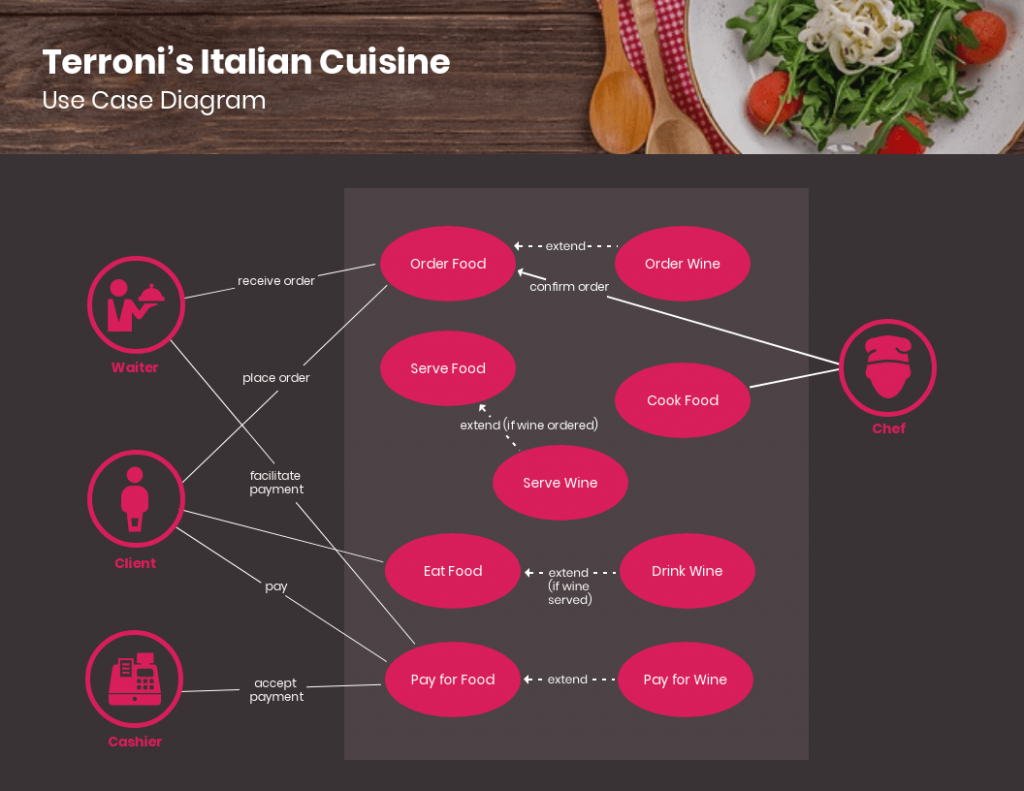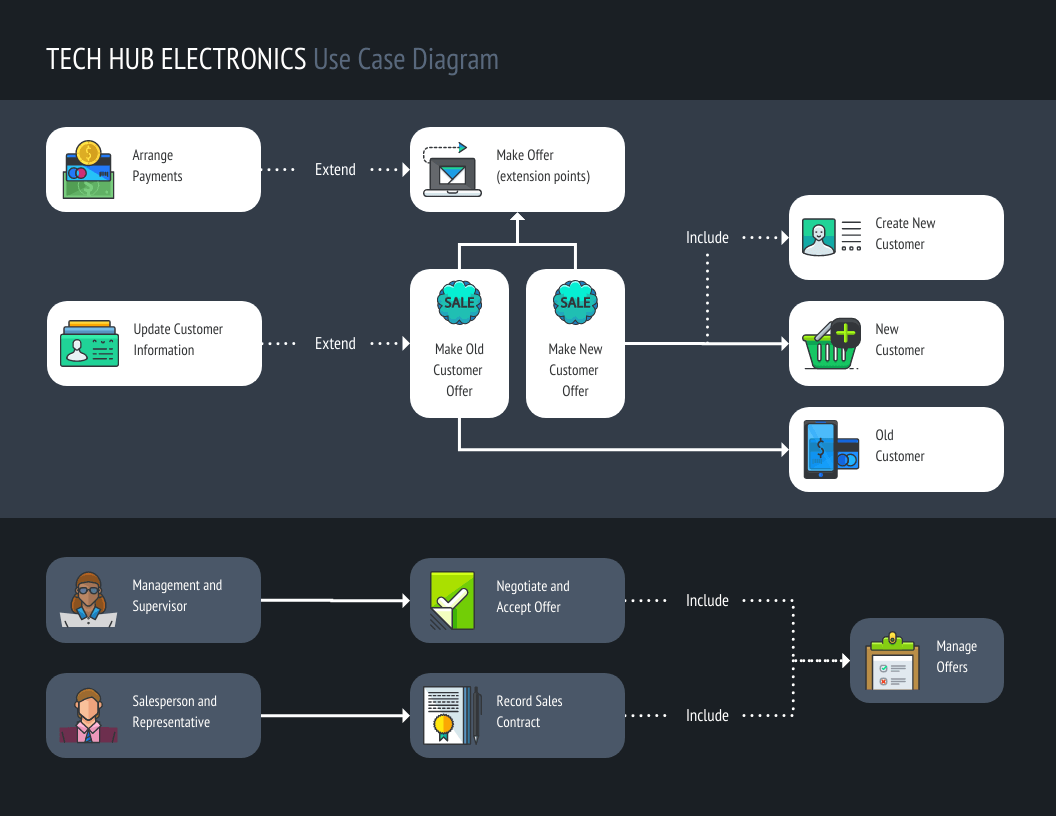

Use case diagrams are a great tool that can help businesses and developers alike to design processes and systems.
By capturing requirements and expectations from a user’s point of view, they ensure the development of correct and efficient systems that will properly serve a user’s goals.
In this article, we will define what a use case diagram is and provide you with different use case diagram examples.
You can create your own use case diagrams using Venngage’s Diagram Maker and use case diagram templates. No design experience is required!
Click to jump ahead:
A use case diagram is a visual representation of the different ways and possible scenarios of using a system. It illustrates how a user will perform actions and interact with a particular system, such as a website or an app.
For example, this use case diagram depicts the different functions of a banking system for customers:

In Unified Modeling Language (UML), systems are presented at different levels of detail to show a specific perspective in the system’s design. Use case diagrams are considered UML diagrams.
UML diagrams define and organize the high-level functions and scope of a system. By modeling the basic flow of events in a use case, they help identify the goals that you need to achieve with every system-user interaction.
Here are some use case diagram templates and examples to guide your diagram creation process:
This use case diagram example depicts the internal functions and employee interactions within a retail system.

It features basic system functions represented by color-coordinated boxes to signify use cases based on the user’s role. A use case diagram like this can be of great use to retail stores with B2C e-commerce systems.
Design a use case or UML diagram that reflects your brand with Venngage’s My Brand Kit feature.
Add your website when prompted and the editor automatically imports all your brand assets, including your logo, colors, and fonts.
In this example, a restaurant’s daily operations serve as the system, the staff represent the actors, and their tasks are the use cases.

This use case diagram can be particularly helpful to restaurants or fast-food chains in terms of systemizing routine processes and presenting day-to-day activities to employees in a simpler and more orderly way.
Here is a use case diagram that maps out how different types of users can engage with a travel booking website or application.

This comprehensive template includes extended use cases marked by dotted lines and arrows instead of simple lines. It can be scaled down or up for hotels, airlines, and other travel reservation systems.
Designed for automated teller machine (ATM) systems, this use case diagram portrays different types of transactions as use cases.

As this example is very simple and contains only essential elements, it can be adapted for other banking systems like branch banking or online banking.
Last but not least, this use case diagram example illustrates how sales and management teams can use a retail system to carry out tasks.

It can be applied to retail systems for consumer electronics and home appliances, fast-moving consumer goods, and other retail sectors.
Ready to master use case diagrams? Check out our blog for everything you need to know and more use case diagram examples for your inspiration.
Use case diagrams can aid your development process with the following benefits:

Create use case diagrams that are easy to understand with Venngage’s extensive icon library. We offer 40,000+ icons, including diverse people icons, so your diagrams can reflect your users more accurately.
Double-click an icon in your chosen template, and choose from the options in the menu.
There are many different types of diagrams that can be used for designing and representing systems and processes. As for UML use case diagrams, they are classified into two types: behavioral and structural UML diagrams.
Behavioral UML diagrams provide a standard way to visualize the design and behavior of a system. Under them are 7 other types of diagrams which are:
As an example, this use case diagram portrays how an ATM system will behave or react when a customer or administrator performs an action.

Structural UML diagrams on the other hand focus on depicting the concepts involved in a system and how they relate to each other. There are also 7 types of structural UML diagrams:
Use case diagrams contain a combination of different elements and specialized symbols and connectors. Whether you want your use case diagram to be simple or in-depth, it should include the following basic components:


Use case diagrams describe the relationship between the users, the system, and its use cases. They do not need to go into a lot of detail and explain how the system operates internally. Here is a guide on what to include and what not to include in your use case diagram:
What to include:
What not to include:
Here are some situations where applying use case diagrams can be particularly useful:
Early stages of system development:
Communication and collaboration:
Testing and documentation:
Beyond these situations, consider using use case diagrams when:
Writing a use case diagram involves deconstructing processes in order to reveal a basic overview of your system. Here are some steps that you can follow:
Step 1: Identify the actors (users) who are going to be engaging with your system. Categorize each type of user based on their roles.
Step 2: Pick one type of user and list what actions they would take using the system. Each action becomes a use case.
Step 3: Create a goal for every use case. Identify what is required from the system to achieve these goals.
Step 4: Structure the use cases. Include in the description for each use case the basic course of events that will happen when a user performs a certain action. It should describe what the user does and how the system responds.
Step 5: Take into consideration alternate courses of events and add them to extend the use case.
Step 6: Repeat steps 2-5 to create a use case diagram for each type of user.
There are various tools and software available for creating a use case diagram. For starters, you can try Microsoft Visio which is a diagramming and vector graphics application that is part of the Microsoft Office family.
You can also go for web-based software if you don’t want the hassle of downloading, installing, and updating programs. Venngage’s diagram features include pre-made use case diagram templates that you can customize for your business and development needs.
Creating a use case diagram can help you illustrate how your system can fulfill the needs and goals of your users. Make sure to use Venngage’s diagram maker to create a successful use case diagram for your next project.
Letícia is a Content Marketing Specialist, and she is responsible for the International strategy at Venngage.
Discover popular designs